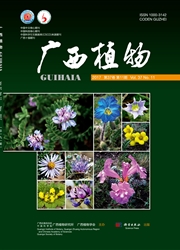

 中文摘要:
中文摘要:
结合民族植物学和药理学的研究方法,对西双版纳地区傣族、哈尼族和基诺族等3个少数民族民间利用番石榴(Psidium guajava)、余甘子(Phyllanthus emblica)和水柳(Homonoia riparia)的传统知识进行调查研究及体外抗菌活性实验。结果表明:番石榴和余甘子在村寨中较为常见,当地少数民族将其种植于庭院中,常作为果蔬食用,食用番石榴嫩叶可缓解拉肚子的症状,治疗腹痛、腹泻。水柳生长在水边,傣族会将其叶作为腌酸鱼的配料之一。根据文献记载,番石榴、余甘子和水柳的叶部位作为药使用时,常煎水外洗,治疗皮肤瘙痒。对这3种药用植物叶部位采用80%乙醇浸泡制备的提取物进行体外抗菌实验,结果显示番石榴、余甘子和水柳3种药用植物对金黄色葡萄球菌和大肠埃希菌均有较好的抑菌和杀菌活性,其最小抑菌浓度MIC在98~390μg·mL^-1之间,最小杀菌浓度MBC在98~781μg·mL^-1之间。番石榴和水柳叶对铜绿假单胞菌有一定抑菌和杀菌活性,其MIC和MBC范围均为6 250~12 500μg·mL^-1。由此可见,这3种药用植物的民间利用具有一定的合理性和药用开发价值。
 英文摘要:
英文摘要:
Xishuangbanna is the birth-place of ethnobotanical study in China,and it has high level of biological and cultural diversity. The local people of Xishuangbanna have collected and inherited a great amount of indigenous knowledge and experience when they struggled to survive from the rugged environment and tropical diseases. Our ethnobotanical and pharmacological survey showed that Psidium guajava,Phyllanthus emblica,and Homonoia riparia were commonly utilized as daily seasonings,fruits,vegetables and medicines by local villagers in Xishuangbanna. The antimicrobial activity test of these three plants was conducted to verify their usage. Our field survey showed that Psidium guajava and Phyllanthus emblica were frequently found growing in villagers' yards,and they were both used as vegetables and fruits by the Dai,Hani and Jinuo people in Xishuangbanna. On the other hand,the young leaves of Psidium guajava were eaten raw or boiled in water for abdominal pain and diarrhea in the folk. Homonoia riparia,usually found nearby stream and river,was used as seasoning to make dai flavor sour fish by Dai people. According to literature,the leaves of the three medicinal plants are boiled in water and externally used for skin disease such as pruritus. For the antimicrobial activity,the minimal inhibitory concentration and minimal bactericidal concentration( MIC and MBC) were determined. The 80%ethanol leaves extracts from them showed significant activities on Stphylococcus aureus and Escherichia coli,with the MIC and MBC ranging from 98- 390 μg·mL^-1 and 98- 781 μg·mL^-1,respectively. In addition,the leaves extracts from Psidium guajava and Homonoia riparia showed weak activities against Pseudomon asaeruginosa with the MIC and MBC ranging from 6 250- 12 500 μg · mL^-1. The relatively obvious antimicrobial activities of the selected three medicinal plants used by local villagers for stomach and skin diseases showed that these plants had the rationality and potential of medicinal applications.
 同期刊论文项目
同期刊论文项目
 同项目期刊论文
同项目期刊论文
 期刊信息
期刊信息
